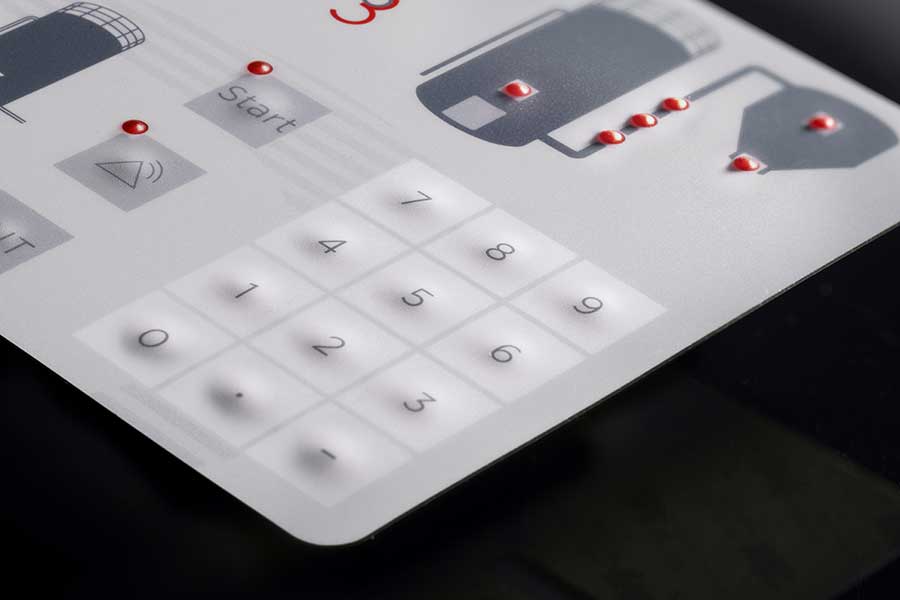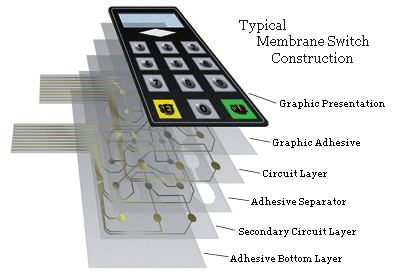Selecting the right membrane switch manufacturer can positively impact your product's quality.
Selecting the right membrane switch manufacturer can positively impact your product's quality.
Blog Article
Everything About Membrane Change: Understanding Its Design and Capability
When you assume regarding the control interfaces in modern-day tools, membrane switches usually come to mind. Let's discover what collections membrane layer switches apart from other control systems.
What Are Membrane Buttons?

Membrane buttons can also be customized concerning shape, size, and graphics, enabling makers to create special user interfaces customized to certain products. On the whole, membrane layer buttons play a substantial duty in improving customer experience throughout a vast variety of applications.
Exactly How Membrane Layer Switches Job
When you push a secret on a membrane button, it turns on an uncomplicated yet efficient device. membrane switch manufacturer. The top layer, often made of flexible product, pushes down onto a conductive layer below it.
You'll observe that the tactile feedback differs based upon the switch layout, offering either a soft click or an extra noticable reaction. Once you launch the key, the membrane layer go back to its initial setting, resuming the circuit and stopping the signal. This procedure happens practically immediately, ensuring a receptive customer experience.
Membrane layer buttons are preferred because of their durability and resistance to dust and dampness, making them suitable for numerous applications, from home home appliances to clinical tools. Comprehending this operation aids you value their widespread use.
Trick Elements of Membrane Switches
Recognizing the vital elements of membrane switches is fundamental for realizing their performance and layout. At the core, you'll locate the graphic overlay, which supplies the visual user interface for individuals. Underneath that, there's a spacer layer that divides the circuit layers, making sure that they do not make call till pushed. The circuit layer is where the magic takes place; it contains conductive traces that complete the circuit when you press the button. Another important element is the sticky support, enabling the switch to comply with surface areas securely. The safety layer guards against ecological aspects and put on, expanding the button's life expectancy. Each part plays a substantial role in ensuring dependable efficiency and user communication. By comprehending these parts, you'll acquire understanding into exactly how membrane layer switches run and their importance in different applications.
Products Utilized in Membrane Change Style
The performance and toughness of membrane changes heavily depend upon the materials made use of in their style. You normally experience polyester and polycarbonate as primary substratums as a result of their exceptional strength and adaptability. These materials stand up to scratches and chemicals, making them ideal for requiring environments.
The conductive layers usually utilize silver or carbon, selected for their reliability and conductivity. membrane switch manufacturer. Silver offers remarkable performance, while carbon is a cost-effective alternative. For the overlay, look at these guys you could think about a matte or shiny surface, depending upon your aesthetic demands and individual experience
Make certain to choose adhesives that withstand ecological elements like temperature and humidity. Choosing the ideal materials will certainly assure your membrane layer button stands browse around these guys the examination of time.
Design Factors To Consider for Membrane Layer Switches
While designing membrane layer switches, it's important to consider numerous elements that influence their capability and user experience. Begin by concentrating on the design and button size; ensure they're instinctive and easy to navigate. Consider the tactile comments you wish to offer-- will individuals need a visible click or a softer touch? In addition, consider the materials you'll use, as they'll affect resilience and visual appeals.
Verify your design accommodates environmental factors, like dampness or temperature level variants, which can influence efficiency. By very carefully thinking about these components, you'll produce a membrane layer switch that enhances usability and fulfillment.
Applications of Membrane Layer Switches
Membrane switches are flexible elements found in different applications, from industrial devices to consumer electronic devices. You'll see their effect in makers that need sturdy interfaces and in devices that benefit from sleek layouts. Comprehending these applications assists you appreciate the performance and practicality of membrane layer buttons in everyday modern technology.
Industrial Tools Usage
When you're looking to boost the functionality of industrial devices, membrane switches use a trustworthy solution that incorporates sturdiness with straightforward layout. These buttons are ideal for rough atmospheres, giving resistance to dust, moisture, and chemicals. Accept membrane layer switches to improve your operations and boost general efficiency.
Customer Electronic Devices Combination
In the domain of consumer electronic devices, membrane layer buttons play an essential duty in improving individual communication and gadget functionality. You'll locate them in gadgets like microwaves, remotes, and video gaming consoles, supplying a smooth way to communicate with modern technology. Their sleek layout permits easy combination into various items, making controls intuitive and user-friendly. With their capacity to incorporate graphics and backlighting, you Continue can enjoy a modern visual that enhances the gadget's general appearance. Membrane buttons likewise ensure toughness and resistance to dust and moisture, extending the lifespan of your electronics. By selecting membrane layer buttons, you boost not simply the functionality yet additionally the design of your gadgets, making everyday communications smooth and satisfying.
Benefits and Drawbacks of Membrane Layer Buttons
While membrane buttons supply a variety of benefits, they likewise come with some disadvantages that you must think about. One considerable advantage is their portable style, making them optimal for space-constrained applications. They're likewise economical, providing a long lasting solution with a low production expense. Furthermore, their seamless surface area is simple to tidy, enhancing health in environments like health centers.

Membrane layer switches can have a shorter lifespan compared to mechanical switches, specifically under hefty usage. They can likewise be much less responsive, which may affect customer feedback during operation. Stabilizing these pros and cons will help you identify if membrane buttons are the right fit for your task.
Frequently Asked Inquiries
For How Long Do Membrane Changes Generally Last?
Membrane layer switches over usually last in between 5 to 10 years, depending upon use and environmental conditions. You'll intend to assess factors like wear, direct exposure to moisture, and temperature level changes to gauge their durability effectively.
Can Membrane Layer Changes Be Personalized for Specific Designs?
Yes, you can tailor membrane buttons to fit specific layouts (membrane switch manufacturer). You'll have the liberty to select colors, forms, and designs that match your project's demands, guaranteeing they blend effortlessly with your overall visual
What Is the Cost Variety for Membrane Switch Over Manufacturing?
The expense variety for membrane layer button manufacturing commonly falls between $1 and $10 per system, depending on variables like layout intricacy, amount, and products. You can get quotes from producers to find the best option.

Are Membrane Layer Changes Water-proof or Resistant?
Membrane layer switches can be designed to be water-proof or immune, relying on materials utilized and building and construction approaches. If you need them for wet atmospheres, assure you specify those requirements throughout the design procedure.
Exactly How Do Membrane Switches Compare to Standard Buttons?
Membrane layer buttons are normally thinner and more flexible than standard buttons, providing a sleek style. They're usually much easier to cleanse and integrate, however may not offer the tactile responses you're made use of to with mechanical choices.
Final thought

Report this page